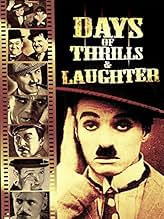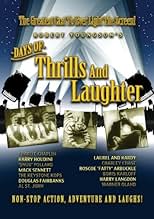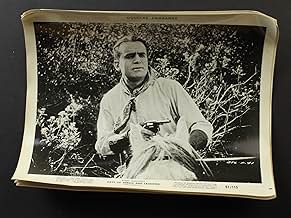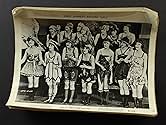Ajouter une intrigue dans votre langueAn appreciative, uncritical look at silent film comedies and thrillers from early in the century through the 1920s. It starts with a 1905 look at French comedy, goes through the 1910s with S... Tout lireAn appreciative, uncritical look at silent film comedies and thrillers from early in the century through the 1920s. It starts with a 1905 look at French comedy, goes through the 1910s with Sennett, Chaplin, and Fairbanks, and into the 1920s with Max Roach, Snub Pollard, Harry Lan... Tout lireAn appreciative, uncritical look at silent film comedies and thrillers from early in the century through the 1920s. It starts with a 1905 look at French comedy, goes through the 1910s with Sennett, Chaplin, and Fairbanks, and into the 1920s with Max Roach, Snub Pollard, Harry Langdon, Al St. John, Charlie Chase, and the teaming of Laurel and Hardy. Thrillers feature H... Tout lire
- Director
- Writer
- Stars
- Self
- (archive footage)
- (as Fatty Arbuckle)
- Self
- (archive footage)
- (as Charlie Chaplin)
- Self
- (archive footage)
- (as Charlie Chase)
- Self
- (archive footage)
- Self
- (archive footage)
- Self
- (archive footage)
- Self
- (archive footage)
- (as Houdini)
- Self
- (archive footage)
- Self
- (archive footage)
- Self
- (archive footage)
- Self
- (archive footage)
- (as Snub Pollard)
- Self
- (archive footage)
- Self
- (archive footage)
- Self
- (archive footage)
- Self
- (archive footage)
- Self
- (archive footage)
- Self
- (archive footage)
- Self
- (archive footage)
Avis en vedette
If you were to pick the top three most famous and important silent comedians, you would certainly have Charlie Chaplin, Harold Lloyd and Buster Keaton. Why, then does this film only have Chaplin clips along with those of inferior comedians such as the VERY obscure Arthur Stone as well as a comedy with Douglas Fairbanks which is more an adventure picture? Why feature a Houdini film when there was NOTHING comedic about it and when Houdini never was a big film star?! And, why feature Al St. John when he was mostly the sidekick for Fatty Arbuckle during the teens and 1920s?! No...there really is no logic to any of these choices. I think this is because Robert Youngson already made a few similar films and here he has given up being as educational and thorough as he was in "The Golden Age of Comedy" or "When Comedy Was King".
The bottom line is that this film is essentially a time-passer and NOT really for anyone wanting an education about silent comedies. Worth watching but I would try finding some of Youngson's other compilations instead.
Selected from hundreds of hours of vintage film clips, producer Robert Youngson brings to the viewer the funniest scenes ever captured on film from the likes of Charley Chase, Stan Laurel, Mack Sennett, "Snub" Pollard, Oliver Hardy, The Keystone Kops, Boris Karloff and Kewpie Morgan.
This delightful anthology is a treasure-filled look at yesterday, reminding all of the invention and artistry of uninhibited movie-making that took place during the silent era.
Presented in b&w, Days Of Thrills & Laughter (which is jam-packed with uproarious sight-gags, fast-paced car chases and elaborately staged pranks) has a running time of 93 minutes.
Le saviez-vous
- AnecdotesThis film makes extensive use of Chopin's "Tristesse" and Franz Von Suppe's "Morning, Noon and Night in Vienna".
- GaffesIn the opening sequence, a filmed fight between the hero and the villain is supposedly projected in slow motion. Yet, the villain's coat moves in real time, indicating that the actors had staged the slow-motion effect.
- Générique farfelu"Days of Thrills and Laughter" opens with what the narrator calls "the first double-feature title" in which the opening credits are shown on the right-hand side of the screen while an excerpt from the 1922 Snub Pollard comedy "The Movies" is displayed on the left.
When the credit for the film's composer-conductor appears, the narrator calls out, "Hold it!" and both sides of the frame freeze. "OK, bring up that name," intones the narrator, as "Jack Shaindlin" expands to nearly the full width of the frame. The narrator declares, "That's enough!," the name shrinks back to its original size, and the movie starts up again, with the narrator explaining, "Sorry, folks, it's in his contract."
At the end of the credits sequence, the movie freezes once again so producer-writer Robert Youngson's name can do a cartwheel while expanding to large size. To which the narrator exclaims, "What a showoff! Take Youngson down - all the way down!" as the name shrinks and disappears.
- Autres versionsThere is an Italian edition of this film on DVD, distributed by DNA srl, "NUOVI PERICOLI PER STANLIO E OLLIO (S.O.S. Stanlio & Ollio) + EMOZIONI E RISATE (Tempo di ridere)" (2 Films on a single DVD), re-edited with the contribution of film historian Riccardo Cusin. This version is also available for streaming on some platforms.
- ConnexionsEdited from The Cure (1917)
Meilleurs choix
Détails
- Date de sortie
- Pays d’origine
- Langue
- Aussi connu sous le nom de
- Jubel, Trubel, Sensationen
- société de production
- Consultez plus de crédits d'entreprise sur IMDbPro
- Durée1 heure 33 minutes
- Couleur
- Mixage
- Rapport de forme
- 1.33 : 1
Contribuer à cette page






































